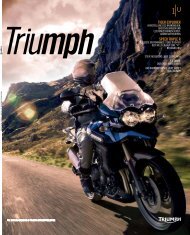Angels - PageSuite
Angels - PageSuite
Angels - PageSuite
Create successful ePaper yourself
Turn your PDF publications into a flip-book with our unique Google optimized e-Paper software.
AMAZONAS<br />
40<br />
some of the young in our luggage on the journey home.<br />
The wild-caught individuals supposedly originated from<br />
the Río Orinoco in Venezuela, from the area around<br />
Puerto Ayacucho. They were much more compact and<br />
beefier in their body form than the true Pterophyllum<br />
altum from the upper Orinoco drainage.<br />
But despite intensive efforts and a 370-gallon (1,400-<br />
L) aquarium, I had no success, and neither did Dr.<br />
Menauer. It was all over by the day after the beginning of<br />
courtship and the cleaning of the chosen spawning site.<br />
However, the fish grew into splendid specimens. Food is<br />
provided in abundance in my tanks, as I still go “ponding”<br />
almost every day. Good feeding is indispensable<br />
for breeding condition and for the rearing of the young<br />
The parents of this variant,<br />
which I have bred for several<br />
generations, came from<br />
Surinam. The precise origin of<br />
the species is a mystery.<br />
Below: Sadly, this disease<br />
syndrome often occurs in<br />
offspring of the Surinam<br />
Angelfish.<br />
brood. Cyclops, Daphnia,<br />
Moina, glassworms, and<br />
mosquito larvae are on the<br />
menu—and not just as frozen<br />
food! Unfortunately,<br />
the excellent menu wasn’t<br />
enough for my Altums.<br />
What was my mistake?<br />
Was it rare to succeed with young fish of the next generation,<br />
as with Heckel Discus? The only answer is to keep<br />
on trying!<br />
Blackwater Altums<br />
In the past year, I finally got to see the blackwater Altum<br />
underwater in the Río Atabapo and in the net. The<br />
fishes reared by Dr. Menauer probably originated from a<br />
population living in the Orinoco, probably at Puerto Ayacucho,<br />
where the Orinoco is a whitewater river. But that<br />
can be deceptive, as there are not only black-, white-, and<br />
clearwater rivers in South America, but also mixed-water<br />
zones, as is the case at Puerto Ayacucho. Some way to the<br />
south, two mighty blackwater rivers, the Sipapo and the<br />
Atabapo, empty into the upper Orinoco.<br />
The fishes from the pure blackwater of the Atabapo (pH<br />
4.5 at a conductivity of around 30 μS/cm in March 2011)<br />
are much more high-backed and filigreed than those from<br />
the Orinoco. Their beige-brown base color also differs from<br />
the blue-green of the Orinoco fishes. In the Atabapo fishes,<br />
red dots predominate on the head region, but the dots are<br />
blue in those from the Orinoco. Unfortunately, we weren’t<br />
allowed to export the fishes from Venezuela. Imports from<br />
there are getting more and more scarce.<br />
When these fishes do reach our shops, they are usually<br />
from Colombia. That is often a death sentence for<br />
Altums, as they are transported from the lowlands to<br />
Bogota, in the highlands. At this altitude, with unheated<br />
tanks, everything depends on how quickly the fishes are<br />
subsequently dispatched. The sensitive Altums are often<br />
chilled and the losses reach 100 percent. But healthy<br />
specimens may soon reach us again.<br />
Because they are now being bred successfully in Germany,<br />
hopefully that will continue in the filial generations,<br />
so that these fishes can be permanently retained in<br />
our aquariums.<br />
H.-G. EVERS




